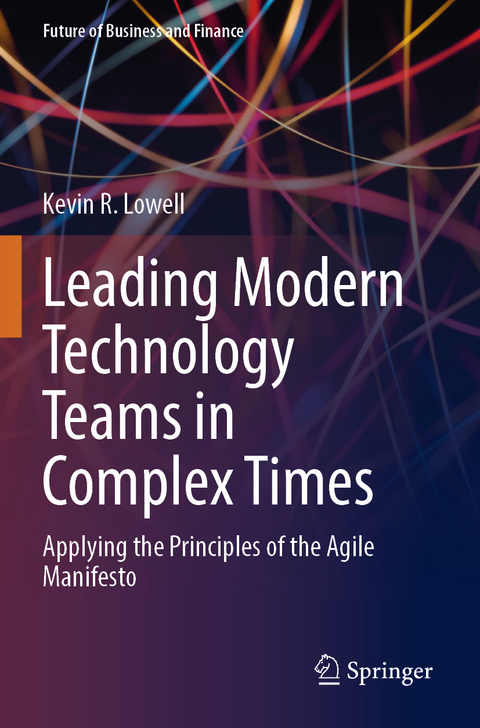
Leading Modern Technology Teams in Complex Times
Springer International Publishing (Verlag)
978-3-031-36431-0 (ISBN)
The practices of agile software development and DevSecOps (Development integrated with Security integrated with Operations) differ from traditional linear systems of working. The people doing this work - who they are and what they expect - and the way the work gets done in today's tech industry demand a leadership practice specific to this way of working. This book explores leadership practice in today's technology industry using the twelve principles of the Agile Manifesto as a framework. Each of the twelve principles includes a section of key takeaways to help the reader apply the principle in practice. It extends traditional notions of leadership, specifically Complexity Leadership Theory (CLT), to one that is post-heroic, acknowledging the processual, conjunctive and generative nature of leadership relationships.
Leader-follower dynamics are complex-they include power dynamics, conflict, ambiguity, and paradox-and technology organizations are complex. This book challenges the suitability of some aspects of complexity theory and offers practices that are more suitable for leading today's technology organizations.
Kevin R. Lowell is Executive Vice President, Chief People Officer and Head of Communications at UScellular Senior Vice President of Information Technology and an Officer for US Cellular, Illinois, USA. He formally served as Senior Vice President of Information Technology. He has served as a distinguished leader for more than 25 years in the high-tech telecommunications industry. He holds a Ph.D. in Organizational Development and Change from Fielding Graduate University, Santa Barbara, CA, USA, certificates in computer science and artificial intelligence, management analytics, artificial intelligence and machine learning from MIT Sloan School of Management, Cambridge, MA, USA and a Community Emergency Response Team (CERT) Certification in Cybersecurity Oversight from the Software Engineering Institute at Carnegie Mellon University, Pittsburgh, PA, USA.
He is a four-time winner of UScellular's Dynamic Leader Award; five-time Finalist of the ChicagoCIO CIO of the Year Award; and winner of the AITP/SIM Chicago CIO Innovator of the Year Award.
His other books include a how-to guide for making changes in your personal life, and a love story.
Part I: The Role of the Leader.- 1. The Role of the Leader.- 2. A few words about complexity.- 3. To the Manifesto!- 4. Using the Agile Manifesto as a framework.- Part II: Leadership in Today's Technology Organizations.- 5. What is leadership?- Part III. Why Change the Way We Lead?- 6. Employee expectations are changing.- 7. The way work gets done is changing.- Part IV: The Twelve Principles of the Agile Manifesto.- 8. Agile Principle 1: "Our highest priority is to satisfy the customer through early and continuous delivery of valuable software.".- 9. Agile Principle 2: "Welcome changing requirements, even late in development. Agile processes harness change for the customer's competitive advantage.".- 10. Agile Principle 3: "Deliver working software frequently, from a couple of weeks to a couple of months, with a preference to the shorter timescale.".- 11. Agile Principle 4: "Businesspeople and developers must work together daily throughout the project.".- 12. Agile Principle 5: "Build projects around motivated individuals. Give them the environment and support they need and trust them to get the job done.".- 13. Agile Principle 6: "The most efficient and effective method of conveying information to and within a development team is face-to-face conversation.".- 14. Agile Principle 7: "Working software is the primary measure of progress.".- 15. Agile Principle 8: "Agile processes promote sustainable development. The sponsors, developers, and users should be able to maintain a constant pace indefinitely.".- 16. Agile Principle 9: "Continuous attention to technical excellence and good design enhances agility.".- 17. Agile Principle 10: "Simplicity--the art of maximizing the amount of work not done--is essential.".- 18. Agile Principle 11: "The best architectures, requirements, and designs emerge from self-organizing teams.".- 19. Agile Principle 12: "At regular intervals, theteam reflects on how to become more effective, then tunes and adjusts its behavior accordingly."
| Erscheinungsdatum | 04.10.2024 |
|---|---|
| Reihe/Serie | Future of Business and Finance |
| Zusatzinfo | XXIII, 183 p. |
| Verlagsort | Cham |
| Sprache | englisch |
| Maße | 155 x 235 mm |
| Themenwelt | Mathematik / Informatik ► Informatik |
| Mathematik / Informatik ► Mathematik ► Finanz- / Wirtschaftsmathematik | |
| Wirtschaft ► Betriebswirtschaft / Management ► Unternehmensführung / Management | |
| Schlagworte | Agile Manifesto • chaos theory • Complexity • Leadership • leading technology teams |
| ISBN-10 | 3-031-36431-7 / 3031364317 |
| ISBN-13 | 978-3-031-36431-0 / 9783031364310 |
| Zustand | Neuware |
| Haben Sie eine Frage zum Produkt? |
aus dem Bereich


